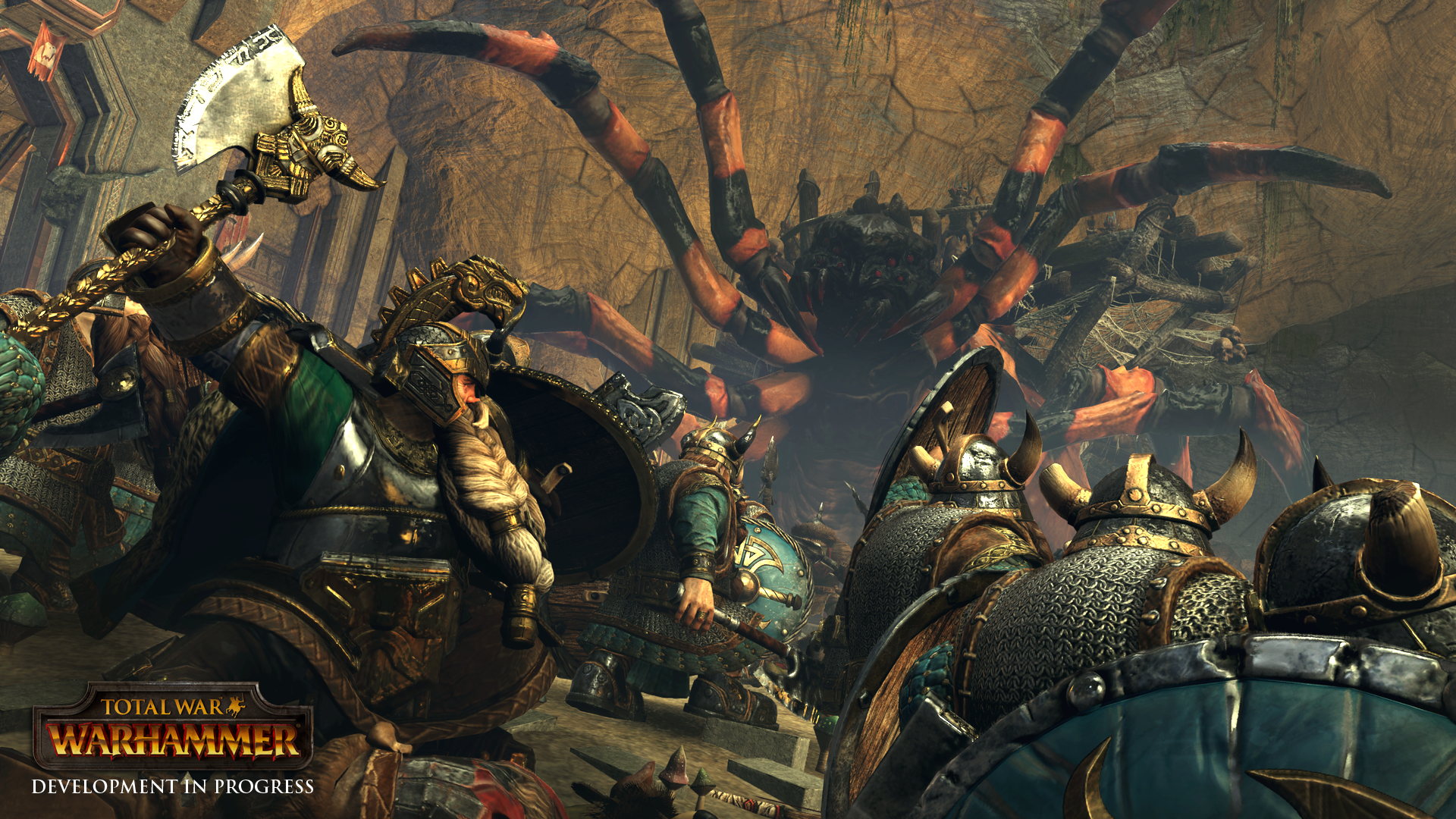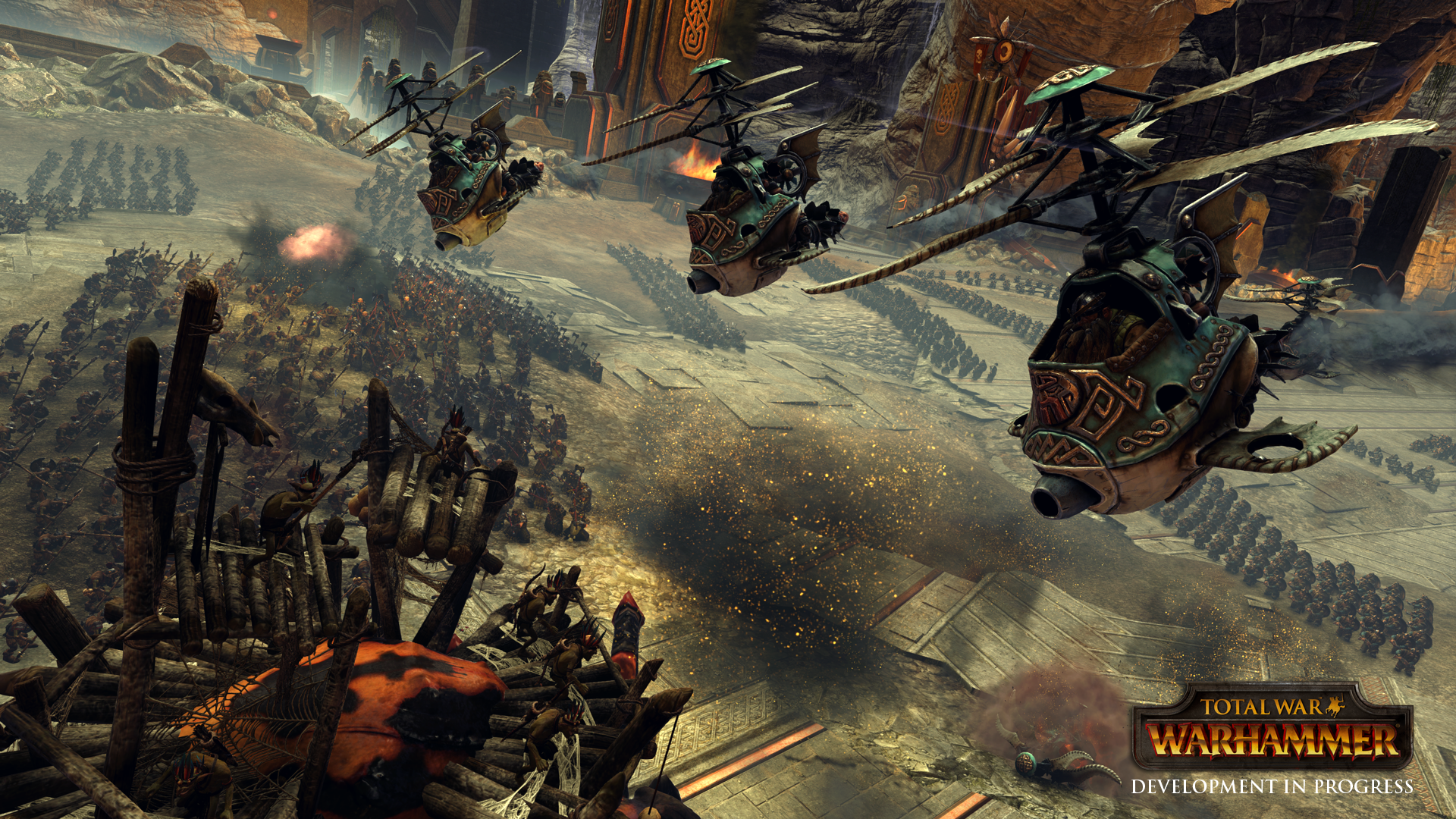Six new things we noticed while playing Total War: Warhammer

We had a lot to say about Total War: Warhammer before we even got to play it, from our first look at the game to our dual impressions (one Total War fan, one Warhammer fan) at E3. That’s a testament to how exciting Creative Assembly’s mash-up of grand warfare and the fantasy world of Warhammer is already looking, but it’s been hard to say, as observers, how TW:W diverges from the formula. Well, now we’ve gone hands-on, playing out a bitter battle to the death as Thorgrim Grudgebearer and his dwarfen army. You can read all about our experience playing Total War: Warhammer and how it’s shaping up right here. But we still had more to say.
During my demo, I talked to designer Richard Aldridge and lead programmer Scott Pitkethly about everything from combat abilities and balance to how animations are being programmed differently thanks to Warhammer’s varied units. Here are the six most interesting things I learned about Total War: Warhammer.
Classic Total War troop formations are gone in Warhammer.
I noticed this immediately, as I’ve recently been playing Rome 2, where battles can be won or lost by a pike unit in phalanx breaking a charge, or a cavalry onslaught in wedge slicing into vulnerable archers.
Rich Aldridge: “Where it’s applicable, where it’s right for the lore, there will be things like that. You’ll still be able to do your standard unit drag-out formations, your grouping up of units to form mini groups, and we also have the army formations. But if you’re talking about going into wedge and things like that, there’s not so much of that because it’s not part of the Warhammer IP. But where it is applicable, where they have used it in their game, we’ll strive to recreate that.”

RPG-esque ‘quest chains’ and loot will be integrated into campaigns.
Throughout campaigns you’ll take on Quest Battles like the one described in our hands-on. These battles will start with a narrative introduction that sets the scene and gives you a taste of Warhammer lore. These battles will be pre-defined, to an extent: Creative Affinity will choose the battlefield and the composition of the enemy army and their reinforcements, but once battle begins, the AI takes over.
At the end of battles you’ll get loot drops, like “new armor or an axe or a health potion” you can use to kit out your characters, says Aldridge. “At the end of a quest chain there will be a significant reward. Ghal Maraz. The axe of Grimnir. Special magical items. You don’t have to take quests, but if you do, you’ll get background story, some of the origins of that character, and a really nice reward at the end that will hopefully make a difference for you in your campaign.”
You can now customize the UI by holding down spacebar in battle.
“If you like the UI of Atilla, you can take off the flags, the banners, switch the icons out,” Aldridge says. “You can go straight to cinematic and wipe the whole lot. You can really make it feel like the tabletop come to life. We’re trying to cater to all of our existing fanbase but new guys as well.”
Keep up to date with the most important stories and the best deals, as picked by the PC Gamer team.

Total War: Warhammer feels fast.
I’ve played a good bit of Rome 2 and Shogun 2, and expect the framerate to dip substantially when I zoom in on hundreds of units fighting it out. That’s the case with Rome 2, even on a powerful Nvidia GTX 980. But my demo of Warhammer felt noticeably, surprisingly fast and fluid even zoomed in on the character models. According to lead programmer Scott Pitkethly, “the way we actually construct the models we’ve made more optimal for Warhammer. So the rendering is faster.”
Speaking of character models, TW:W is brimming with personality, and Creative Assembly did some major work to make battles feel more alive.
Up close, combat looks fantastic, with detailed dwarfs and goblins and all sorts of creatures wailing on each other with axes and clubs, or spiders skittering across the battlefield, or giants picking up their enemies and slamming them to the ground.
Scott Pitkethly explains how they’ve updated the engine since Total War: Atilla to bring Warhammer to life: “We’ve moved to a system of individual combat resolution on an animation basis. Previously we’d have sync times, so we’d be animating these two things in relation to one another, but with the amount of permutations we have that doesn’t really work. If two dwarfs are fighting one troll or a giant is fighting an empire guy, there’s so many different permutations that we wouldn’t be able to create it in that way. So the guys are animating and reacting on an individual basis, but we actually found that made the combat look loads more visceral. Rather than things waiting to get into position to play these match times, they’re constantly animating and reacting and fighting. The combat kind of came alive a little more and looked a little more violent and visceral.
"So now we use the match times as theatrical elements, so when you see the troll picking up the dwarf and smashing him to the ground, or the Arachnarok swallowing the guy and spitting him back out, all that stuff. We’ve done loads of work on the combat system to move in that direction, and I think that’s actually been really positive in the way that’s worked out.”

To maintain progression throughout a campaign, units will be recruitable with different types of weapons—in keeping with Warhammer lore, of course.
I asked Aldridge how Warhammer’s progression throughout a campaign will compare to Rome 2, where you start with weak unarmored troops and gradually upgrade to heavily armored Triarii and Veteran Legionaries, if you’re playing as a Roman faction. “Each of these four races that we’ve said that we’re going to release have got a real plethora of units of great variation to them, but each unit within its own right has at times different weapons they will carry,” says Aldridge. “So that’s kind of something that we’ve looked at and used to flesh out and create a variety of units for the user to play with. May that be spears and shields, greataxes, hammers. There will be opportunities to scope your army. With the dwarfs here you might go down the warrior route with the Slayers and focus on the more hard-hitting units, rather than going down the more technological units with the Iron Drakes and looking at using the flamethrowers and artillery pieces. There will be scope for good progression there.”

Wes has been covering games and hardware for more than 10 years, first at tech sites like The Wirecutter and Tested before joining the PC Gamer team in 2014. Wes plays a little bit of everything, but he'll always jump at the chance to cover emulation and Japanese games.
When he's not obsessively optimizing and re-optimizing a tangle of conveyor belts in Satisfactory (it's really becoming a problem), he's probably playing a 20-year-old Final Fantasy or some opaque ASCII roguelike. With a focus on writing and editing features, he seeks out personal stories and in-depth histories from the corners of PC gaming and its niche communities. 50% pizza by volume (deep dish, to be specific).

